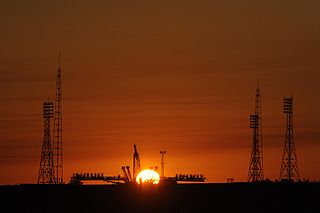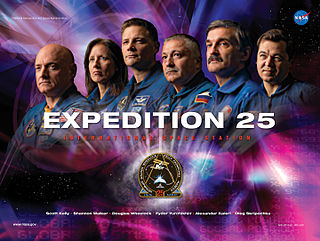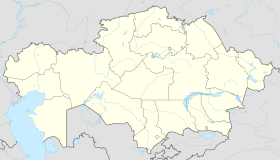
A spaceport or cosmodrome is a site for launching or receiving spacecraft, by analogy to a seaport for ships or an airport for aircraft. The word spaceport, and even more so cosmodrome, has traditionally been used for sites capable of launching spacecraft into orbit around Earth or on interplanetary trajectories. However, rocket launch sites for purely sub-orbital flights are sometimes called spaceports, as in recent years new and proposed sites for suborbital human flights have been frequently referred to or named "spaceports". Space stations and proposed future bases on the Moon are sometimes called spaceports, in particular if intended as a base for further journeys.

The Baikonur Cosmodrome is a spaceport operated by Russia within Kazakhstan. Located in the Kazakh city of Baikonur, it is the largest operational space launch facility in terms of area. All Russian crewed spaceflights are launched from Baikonur.

Baikonur, formerly known as Leninsk, is a city in Kazakhstan on the northern bank of the Syr Darya river. It is currently leased and administered by the Russian Federation as an enclave until 2050. It was constructed to service the Baikonur Cosmodrome and was officially renamed Baikonur by Russian president Boris Yeltsin on December 20, 1995. During the Soviet period, it was sometimes referred to as Zvezdograd (Звездоград), Russian for Star City.

Plesetsk Cosmodrome is a Russian spaceport located in Mirny, Arkhangelsk Oblast, about 800 km north of Moscow and approximately 200 km south of Arkhangelsk. As of 2024, it is Europe's only operational orbital spaceport and the northernmost spaceport in the world. Originally developed as an ICBM site for the R-7 missile, it also served for numerous satellite launches using the R-7 and other rockets. Its high latitude makes it useful only for certain types of launches, especially the Molniya orbits, so for much of the site's history it functioned as a secondary location, with most orbital launches taking place from Baikonur, in the Kazakh SSR. With the end of the Soviet Union, Baikonur became a foreign territory, and Kazakhstan charged $115 million usage fees annually. Consequently, Plesetsk has seen considerably more activity since the 2000s.

Töretam is a station on the main Moscow to Tashkent railway, located in Kazakhstan. The name means "Töre's grave" in the Kazakh language. Töre, or more formally, Töre-Baba, was a nobleman and descendant of Genghis Khan. Töretam is near the Baikonur Cosmodrome, a Russian – formerly Soviet – spaceport, and near the city of Baikonur, which was constructed to service the cosmodrome.

Soyuz TM-13 was the 13th expedition to the Mir space station. Launched from the Soviet Union in October 1991 and lasting until March 1992, the mission included cosmonauts from Austria and the Kazakh Soviet Socialist Republic, the latter of which became an independent state during the mission due to the dissolution of the Soviet Union in December 1991. The launch ceremony at the Baikonur Cosmodrome in Baikonur, Kazakh SSR was attended by the Soviet Premier Ivan Silaev, the President of the Kazakh SSR Nursultan Nazarbayev, and the Chancellor of Austria Franz Vranitzky. Before the launch, for the first time, President Nazarbayev received the launch report from cosmonaut Tokhtar Aubakirov in the Kazakh language.
Svobodny was a Russian rocket launch site located approximately 15 km north of Svobodny, Amur Oblast. The cosmodrome was originally constructed as a launch site for intercontinental ballistic missiles called Svobodny-18. It was initially selected as a replacement for Baikonur Cosmodrome in the Kazakh Soviet Socialist Republic, which became independent as Kazakhstan after the dissolution of the Soviet Union. However the development of Svobodny was subsequently ended in 2007 in favour of a totally new space port, the Vostochny Cosmodrome.

The International Space Company Kosmotras or ISC Kosmotras is a joint project, between Russia, Ukraine, and Kazakhstan, established in 1997. It developed and now operates a commercial expendable launch system using the Dnepr rocket. The Dnepr is a converted decommissioned SS-18 ICBM. ISC Kosmotras conducts Dnepr launches from Baikonur Cosmodrome and Yasny launch base in Dombarovskiy, Russia.

Soyuz TMA-13 was a Soyuz mission to the International Space Station (ISS). The spacecraft was launched by a Soyuz-FG rocket at 07:01 GMT on 12 October 2008. It undocked at 02:55 GMT on 8 April 2009, performed a deorbit burn at 06:24, and landed at 07:16. By some counts, Soyuz TMA-13 is the 100th Soyuz spacecraft to be crewed.

Qyzylorda Region, formerly known as Kyzyl-Orda Region until 1991, is a region of Kazakhstan. Its capital is the city of Qyzylorda, with a population of 234 736. The region itself has a population of 823 251. Other notable settlements include Aral, Kazaly (Kazalinsk) and the Russian-administered Baikonur, which services the Baikonur Cosmodrome. The total area of the province is 226,000 square kilometers (87,000 sq mi).

Gagarin's Start, also known as Baikonur Site 1 or Site 1/5 was a launch site at the Baikonur Cosmodrome in Kazakhstan that was used by the Soviet space program and Roscosmos.

The Vostochny Cosmodrome is a Russian spaceport above the 51st parallel north in the Amur Oblast, in the Russian Far East. It is intended to reduce Russia's dependency on the Baikonur Cosmodrome in Kazakhstan. The first launch took place on 28 April 2016 at 02:01 UTC. As of 1 July 2022, eleven launch attempts have been made with ten successes.

Baikonur Site 31, also known as Site 31/6 at the Baikonur Cosmodrome, in Kazakhstan, is a launch site used by derivatives of the R-7 Semyorka missile. Since Roscosmos' change from flying crew on the Soyuz-FG to the Soyuz-2 launch vehicle for crewed flights in 2020, it has served as the primary launch site for Soyuz flights to the International Space Station. It took over from Site 1/5 after the latter failed to receive funding to modernize it for the slightly larger Soyuz-2 rocket.

Expedition 25 was the 25th long-duration mission to the International Space Station (ISS). Expedition 25 began with the Soyuz TMA-18 undocking on 25 September 2010. Three new crewmembers arrived aboard the ISS 10 October 2010 on Soyuz TMA-01M to join Douglas Wheelock, Fyodor Yurchikhin and Shannon Walker, and formed the full six member crew of Expedition 25. NASA astronaut Doug Wheelock accepted command of Expedition 25 on 22 September 2010, taking over from Russia's Aleksandr Skvortsov. The departure of Wheelock, Walker and Yurchikhin on 25 November 2010 marked the official end of Expedition 25.

The Soyuz 2.1v, GRAU index 14A15, known early in development as the Soyuz 1, is a expendable Russian medium-lift launch vehicle. It is derivative of the Soyuz 2 but utilizing a single core stage built around the powerful NK-33 engine, 50-year-old refurbished remnants from the Soviet N1 moon rocket. It is a member of the R-7 family of rockets built by Progress in Samara. Launches have been conducted from the Plesetsk Cosmodrome in northwest Russia, and are expected to be conducted in the future from the Vostochny Cosmodrome in eastern Russia, and the Baikonur Cosmodrome in Kazakhstan.

Progress M-05M, identified by NASA as Progress 37P, is a Progress spacecraft launched by the Russian Federal Space Agency in April 2010 to resupply the International Space Station (ISS). The spacecraft carried fresh food and supplies for the ISS crew. Progress M-05M also hauled some special care packages for the station crew that included confectioneries, books and new movies.

Elektro–L is a series of meteorological satellites developed for the Russian Federal Space Agency by NPO Lavochkin. The first satellite, Elektro-L No.1, was launched on 2 January 2011. It is the first Russian weather satellite that successfully operates in geostationary orbit, and is currently the second operational Russian weather satellite. The satellites have a mass of about 1620 kg and are designed to operate for 10 years each. They are capable of producing images of the Earth's whole hemisphere in both visible and infrared frequencies, providing data for climate change and ocean monitoring in addition to their primary weather forecasting role.

Soyuz TMA-19M was a 2015 Russian Soyuz spaceflight to the International Space Station. It was launched on December 15, 2015 from Baikonur Cosmodrome, transporting three members of the Expedition 46 crew to the International Space Station. TMA-19M was the 128th flight of a Soyuz spacecraft since the first in 1967. The crew consisted of a Russian commander accompanied by American and British astronauts. The flight returned to Earth on June 18, 2016. The Soyuz TMA-19M descent module is now in the collection of the UK's Science Museum Group.
Baikonur is a city in Kazakhstan rented by the Russian Federation for the Russian space program.
The space program of Kazakhstan is originated from the dissolution of the Soviet Union in 1991, when Kazakhstan declared their independence. The Kazakh space program consist of cosmonaut and satellite missions. The only launch site situated at Kazakhstan is Baikonur Cosmodrome, which is leased to Russia. The program is led by KazCosmos since 2007.

















